|
ZANDVOORDE
OCTOBER 1914
by Major B Rogers
The Life Guards
|
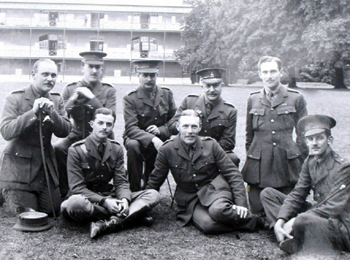
Officers of the 2nd Life Guards, Combermere Barracks, August 1914.
L-R, Back Row: Maj Pemberton, Capt Vandeleur, Capt Lord Belper,
Maj Barry, Lt Stewart Menzies. Front Row: Lt H Farquhar,
Maj Montgomerie (later Earl of Eglington),
Lt Lord Carleton (later Earl of Wharncliffe) |

Lord Tweedmouth - a later photograph |
After the declaration of war on 4th August 1914 the active service squadrons of the three Household Cavalry regiments formed a Composite Regiment which was soon en route to France with the British Expeditionary Force. By 16th August they were in Belgium, and a few days later took part in the long Retreat from Mons which eventually brought them to Ypres in the late autumn.
The remainder of the three regiments formed themselves into the 7th (Household Cavalry) Brigade, and since the Household Cavalry did not have a reserve, they were augmented by line cavalry regiments to replace the missing squadrons that had departed with the Composite Regiment in August. Dragoons came to the 1st Life Guards, Lancers to the 2nd Life Guards, and Hussars to the Royal Horse Guards (The Blues). The Brigade arrived at Zeebrugge on 8th October and two weeks later, as autumn gave way to an early winter with driving rain and sleet, found itself in the trenches to the south east of Ypres, alongside the Composite Regiment.
The Cavalry Corps were now responsible for a 35 mile frontage, with each Cavalry Brigade assigned to approximately 600 yards on a semicircle east of Ypres. Horses were left behind the lines with the No 3 (usually a saddler, farrier or member of the regimental staff) who was responsible for up to six horses. Each squadron mustered around 80 rifles apiece.
Below is an account of the days and battles that followed, based on regimental and personal diaries:
20 October:
Diary of Lord Tweedmouth RHG: ‘Went into trenches at Zandvoorde and relieved The Royals and had a good shelling as we relieved them in broad daylight’.
The Brigade HQ officers, commanding officers and squadron leaders, were on the ridge to conduct a reconnaissance of their positions when they came under German artillery fire; all received injuries but none seriously.
Diary of Tpr R A Lloyd 1LG: ‘Nobody could have named the day of the week and nobody cared. The only factors which reminded us of passing of time were daylight and darkness. Our horses ceased to be employed as cavalry horses. Their role was the rapid conveyance of rifle and bayonet soldiers to the line. The exciting scampering along country roads and through villages gave place to an existence comparable only to that of a water rat in a swamp’.
The horses had no hay for over a month, and were reduced to eating wooden posts, bark and trees for nourishment.
The trenches were not formally constructed as they were later to become; they were no more than pits dug into the sandy soil, each holding around a dozen men. These pits were not continuous along the line, and communications existed laterally or from the rear. Relief was conducted during the hours of darkness, leaving no time or the means to make the positions better.
Dispositions followed the contours of the ridge, with trenches susceptible to artillery fire, averaging 120 shells per day. Casualties were continuous.
Lloyd describes going up with reinforcements: ‘The night was as black as a pit, there was no continuous line, the trenches were a series of holes, for all the world like large graves, not connected and running zig zag across the hillside. At the point where we struck, each trench was chock full of men who absolutely refused to admit us. Once in a trench it was very hard to move without being shelled or sniped at, and rations could only be delivered at night, though the men would creep out to make tea at quiet intervals’.
24 October:
Sir Richard Levigne 1LG was shot and immediately buried. The following day it emerged that he still had the squadron’s pay in the inside pocket of his jacket. He was duly disinterred and the money recovered.
Diary of Lt the Hon Reginald Wyndham 1LG: ‘The village of Zanvoorden behind us is practically destroyed by the German shells. The church is riddled’. In the same entry he also talks about the Germans conducting probing night attacks’.
25-26 October: (heavy rain)
7th (Household Cavalry) Brigade were relieved by 6th Brigade (which included The Royals). The Blues staged a daring mounted operation riding across the front of two German cavalry regiments to cover the retreat of 20th Infantry Brigade. The Blues were told to relieve the pressure on the 7th Division by moving eastwards to Zandvoorde between the trenches held by 1LG. There Alistair Kerr dismounted a squadron on the ridge and opened fire whilst two squadrons galloped on further east flanking the German advance as they turned to engage The Blues.
Lord Tweedmouth’s horse was shot in the shoulder and he leapt into a trench with Hugh Grosvenor. An extract from his diary: ‘Went off at the gallop, to make a demonstration, C Squadron in advance. My sword carried away just as we got to the crest between Hugh Grosvenor’s trench and Gerry Ward’s. We got the shrapnel pretty hot then, and my horse was shot in the leg and I had to stop and get into Hugh’s trench. Got out presently and shot my horse with my revolver and saved all my kit. Found the led horses of D Squadron and went back with them to Zillebeke’.
The Regiment withdrew in the fading light with the loss of 8 men and 25 horses. Trooper Levin was awarded a DCM for special gallantry. The Germans thought the entire Cavalry Corps was behind The Blues and turned their guns and their axis onto them, therefore relieving pressure on 20th Brigade.
The withdrawal of 20th Brigade rendered Zandvoorde even more vulnerable to enemy attack.
27 October:
7th (Household Cavalry) Brigade moved back into the Zandvoorde trenches which, by now, had been moved onto a forward slope.
Diary of Lord Tweedmouth: ‘There are some remarkably good shots in front of our trenches and snipers in concealed positions who pick you off for a certainty if you show your head above your trench... The siting of these trenches are a perfect example of what trenches should not be, being on a forward slope and in full view of the enemy’s trenches and observation posts. Once occupied it is impossible to reinforce them in daylight or to take ammunition up or to communicate between the trenches. I believe General Kavanagh wanted to evacuate them and occupy the reverse slope but was not allowed to’.
28 October:
Intelligence was received (and is recorded in all three regimental war diaries) that a major German assault is expected. Heavy shelling was reported in all areas including Brigade HQ.
Diary of Lord Tweedmouth: ‘A quiet night but shelling in the morning and Jack Johnsons gave their attentions to the village. We watched them bursting about 150 yds from our farm. I went round the trenches in the evening and saw where they had burst. They make a hole 6 ft deep and big enough to put a cart in’.
29 October:
C Squadron 1LG relieved a squadron of The Blues but due to the faulty machine gun, they left behind Lord Worsley and his machine gun section. Heavy artillery bombardment continued throughout the day.
Diary of Lord Tweedmouth: ‘We had a tremendous bombardment of Jack Johnsons especially around Harold Brassey’s trenches. The 1LG are relieving D and half of C Squadron who with Colonel Wilson and myself occupied the reserve trenches. Worsley in the trenches for the sixth night. The smell from the dead cows becomes awful’.
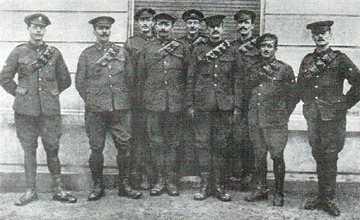
Members of D Squadron, 2nd Life Guards, Christmas Day, 1915.
L-R, Back Row: RA Lloyd, Ted Pettit, Charlie Wright.
Front Row: George Boylan, Fender Wright, Bob Harrison, George Hindy, Fred Lidster, Jim Fleming |
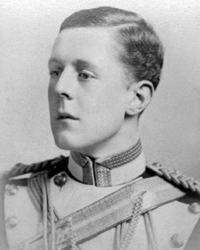
Lt the Hon Reginald Wyndham, in the uniform of the 17th Lancers, his first regiment. He was only with the 1st Life Guards for just over a month (having joined up to go overseas with his two younger brothers), and was killed on 6th November 1914 |
30 October:
At 0645 a bombardment by 260 German guns began. The Germans reported accuracy as difficult, caused by poor visibility and telephone lines being cut by counter-battery fire.
At around 0730 the German 39th Division attacked the line with 3 Jaeger battalions.
Diary of Lord Tweedmouth: ‘After an ominously quiet night the shelling begins all round our house and Brigade HQ. Jack Johnsons and heavy shrapnel hit several men. Corporal Turner came in wounded to say that C Squadron had been literally blown out of their trenches and were retiring. The whole brigade withdrew under heavy shell fire and occupied the trenches in the valley. Germans began to appear on the ridge, but not in large numbers. We retired slowly up the hill to Klein Zillebeke while our guns plastered the ridge. Worsley and machine gun section missing also Hugh Grosvenor’s squadron and Alex Vandeleur’s. D & B Squadrons went down to the Chateau of Hollybeke to reinforce The Royals. Our casualties 60 killed, wounded or missing’.
The line to the right of B Squadron 2LG fell back and the squadron are forced to retire with losses. Runners were dispatched from D Squadron 1LG to C Squadron 1LG (Capt Lord Hugh Grosvenor) with orders to retire but the first two runners were killed en route. The order to withdraw was not received and nearly all the squadron was lost, including Lord Worsley’s machine gun section. C Squadron(-) 2LG (Capt Vandeleur) was surrounded and, according to the account of a sole survivor, it is doubtful if anybody else escaped.
Extract from the diary of Tpr R A Lloyd of a conversation between the troop leader and Tpr Tapper as he attempted to send a 3rd runner: ‘Look here Tapper, I wondered if you would try to get through with a message to C Squadron.’
‘Wot me, Look at them two poor blighters out there! No fear, It’s too bloomin late anyway’.
‘I say Tapper your nerves are all in pieces, have a jujube’. (jujube was a morphine tablet)
‘Ave a wot, my nerves is alright, ave a bloomin jujube yourself, I may be a bloody fool but I ain’t as big a fool as you think’.
The conversation was cut short by another German infantry assault.
A creeping barrage moved towards Brigade HQ at 0800 where C Squadron RHG were blown out of their trenches. Brigadier Kavanagh ordered a withdrawal to reserve positions in the valley to the west and then a move back to Klein Zillebeke.
Extract from a letter by Capt Stewart Menzies, Adjutant 2LG: ‘Practically nothing is known of what occurred as the two squadrons and the machine guns of The Blues completely disappeared, and only very few survivors were taken prisoner, and on their return at the end of the war they were unable, I understand, to throw much light on the attack. I can only conclude that the squadrons were cut off owing to their somewhat forward position and were ultimately all killed, though it is remarkable that there should have been so few taken prisoner. Some of the trenches were very primitive, and I remember one that was too deep to allow the occupants to see over the top, and they would hardly be in a position to offer any effective resistance. But on the other hand other trenches were quite well sighted and the whole incident has always struck me as one of the most remarkable occurrences of the war. I fear that one must assume that the Germans behaved in an ultra Hunlike manner and gave no quarter’.
Extract from the diary of Lt the Hon Reginald Wyndham 1LG: ‘In the morning they attacked us. They shelled us hard, and one of the first shells buried Dawes all except his head, and also buried my belt, pillow, glasses and haversack. Then their infantry attacked, we knocked a good few over, but the Maxim on our right ran out of ammunition, and one trench on our right was driven in. We kept on firmly until our ammunition was finished. The spare box was buried by the shell which buried Dawes. In the end we had no more ammunition and they began to enfilade us from our right. Had to order Sgt Arthurs to retire from the right hand trench, and then ordered my troop to retire. Previous to this had dug Dawes out with my hands. Before we started to retire Cpl Brooks had been slightly hit in two places. We ran back to the farm, the Maxim killed Sgt Arthurs. Then after finding Clowes had left the farm, I went on, and found Dawes and Brooks, Dawes was slightly hit. We found Bussey badly wounded, but could not move him. We picked up a man of Arthurs’ troop and helped him along until he dropped dead. Then when we reached the X roads where Levigne was buried, Dawes had his leg broken by the shell fire. The shells had been bursting over us all the way. Had to leave Dawes lying where he was. Then met Humphrey, who told me the order to retire had been signalled to me. Then met General Kavanagh who told me he wished me to retire. Then set to work to find the men. Found most of them when we got back to the horses. As we retired down the road, the Germans shelled us and Charlie Fitzmaurice was killed. Then found that my troop of twenty had 9 killed and wounded, and there were only 7 left of Arthurs’ troop of 26 men. Pickles Lambton was killed last night and they say that Hugh Grosvenor and all his squadron bar Jerry Ward and a few men are missing’.
Field Marshal Haig recounted at the end of the war: ‘They were in narrow trenches on the forward slopes before us in full sight of the enemy. Their trenches were soon blown in and at 8am after one and a quarter hours bombardment the whole of the 39th German Infantry Division and three battalions of Jaegers attacked their shattered position. The time had come to slip away and orders were issued for the retirement to the second line; but the greater part of two squadrons of Life Guards on the left and the Royal Horse Guards machine guns could not get away and were cut off and died to a man, except for a few wounded prisoner’.
31 October: (Household Cavalry Composite Regiment)
A second German offensive fell against the Composite Regiment manning the trenches between Wytschaete and Messines. Lt Col Cook had been wounded by an artillery shell on 20 October and Lord Cavendish had been killed, so command had passed to Maj the Viscount Crichton (The only Household Cavalryman with a marked grave in the Zandvoorde CWGC).
Anonymous source: ‘Under the rays of the moon the Germans open mouthed and heavy handed came as it seemed straight for the composite regiment, line after line and shoulder to shoulder. At 200 yards the regiment opened fire and poured in round after round. and at any rate saw live men climbing over their dead colleagues to then fall themselves. The Germans swung left-handed short of The Blues’ trenches to engage in hand-to-hand fighting. Twice B and C Squadrons were driven out and twice they came back to regain what they had lost against overwhelming odds. Eventually they could hold on no longer and the Germans worked their way round The Blues and Maj the Viscount Crichton ordered them to fall back as the Lincoln Regiment came to reinforce. The line held but at a terrible cost:
Maj Viscount Crichton was killed during the action.
The regiment mustered the following day:
30 men of the 1st Life Guards
3 men from the 2nd Life Guards
30 men from the Royal Horse Guards’
This was the last action of the Composite Regiment; on 11th November the survivors re-joined their regiments as part of the 7th Brigade.
On 31st October, a German officer and nobleman came across the trench of Lord Worsley who had commanded the machine guns of The Blues. He found the body trapped by one of the guns and decided to have a grave dug and a simple wooden cross erected. Four months later the War Office issued a certificate received through the American Embassy that Lord Worsley had been buried south of Zandvoorde, with a detailed map of where he had been buried. After the war, the grave was located; only the vertical post was still in place. A new simple cross was placed on the grave by Sackville Pelham, Lord Worsley’s brother, who also took a cutting from a battered osier fence which was the only thing left living on the ridge line. In September 1921, Lord Worsley’s body was exhumed and finally laid to rest in the cemetery in Ypres.
Lady Yarborough, along with other families of the deceased, bought the land where the original grave was, where the 21 foot high Household Cavalry Memorial now stands. It commemorates the 120 members of 1LG, 159 members of 2LG, and 62 men of The Blues who died in the surrounding area. It was unveiled by Field Marshal Haig on 4th May 1924.
The Zandvoorde CWGC holds the remains of 1583 servicemen, 1135 of them unidentified but numerous no doubt are Household Cavalrymen, the only marked grave being of Major the Viscount Crichton RHG.
The cutting from the osier tree was planted in the grounds of the Worsley family estate in Lincolnshire. Subsequent cuttings were taken from the tree and given to the Grosvenor family and again presented to the Regiment, and the tree now stands inside the gates at Combermere Barracks, Windsor.
Cuttings were taken from this tree in 2013 and re-planted in the nearby Savill Gardens. One of these saplings was planted in the Passchendaele Memorial Garden on 26th October 2014 by Lady Jane Dawnay and Lord Yarborough representing the Grosvenor and Worsley families respectively.
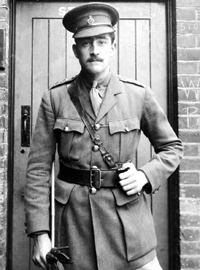
Lord Hugh Grosvenor, who was killed on 30th October 1914
|
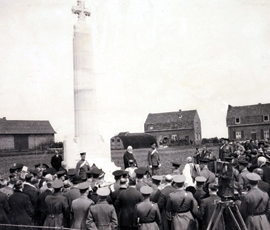
The unveiling of the Household Cavalry Memorial,
4th June 1924 |
|
|






